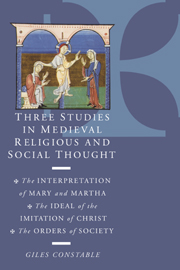 Three Studies in Medieval Religious and Social Thought
Three Studies in Medieval Religious and Social Thought Book contents
- Frontmatter
- Contents
- List of illustrations
- Preface
- List of abbreviations
- I THE INTERPRETATION OF MARY AND MARTHA
- II THE IDEAL OF THE IMITATION OF CHRIST
- The imitation of the divinity of Christ
- The imitation of the humanity of Christ
- The imitation of the body of Christ
- The late Middle Ages
- III THE ORDERS OF SOCIETY
- Bibliography of secondary works
- Index of manuscripts
- Biblical index
- General index
The late Middle Ages
Published online by Cambridge University Press: 08 December 2009
- Frontmatter
- Contents
- List of illustrations
- Preface
- List of abbreviations
- I THE INTERPRETATION OF MARY AND MARTHA
- II THE IDEAL OF THE IMITATION OF CHRIST
- The imitation of the divinity of Christ
- The imitation of the humanity of Christ
- The imitation of the body of Christ
- The late Middle Ages
- III THE ORDERS OF SOCIETY
- Bibliography of secondary works
- Index of manuscripts
- Biblical index
- General index
Summary
after the twelfth century the ideal of the imitation of Christ increasingly entered the main stream of late medieval spirituality and became equated with following Christ and, more generally, with the Christian way of life. It tended to divide, however, along the lines established in the previous period. Some writers, including mystics and humanists as well as theologians, maintained the ancient doctrine of deification by which Christ showed the way to become God with Him. Others concentrated on Christ's humanity, both on His sufferings and on His activity and behaviour during His life on earth. These ways were sometimes distinguished. A text of 1404, which will be cited below, maintained that it was more perfect to imitate Christ ‘in sufferings than in actions (in passionibus quam actionibus)’, and many late medieval saints inclined, as Kieckhefer put it, ‘with exceptional consistency and with dramatic intensity toward the inimitable extremes’, which were intended to arouse admiration and to provoke reform rather than imitation. Others were inspired by the more internal and moral ideal set forth in the Meditations on the life of Christ and various Lives of Christ and above all in The imitation of Christ, from which suffering was not excluded but which presented Christ as the exemplar of life for all Christians.
- Type
- Chapter
- Information
- Three Studies in Medieval Religious and Social ThoughtThe Interpretation of Mary and Martha, the Ideal of the Imitation of Christ, the Orders of Society, pp. 218 - 248Publisher: Cambridge University PressPrint publication year: 1995
